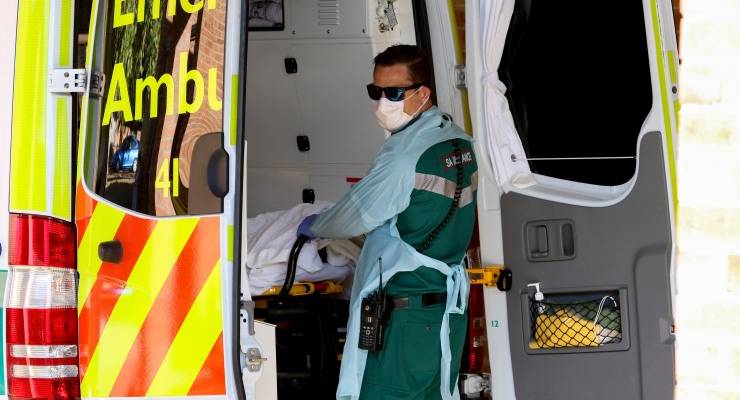
Last Wednesday, Sydney doctor Lucy Morgan appeared alongside Gladys Berejiklian at the NSW press conference to vividly describe some symptoms experienced by her patients with COVID-19. The speech has been widely praised as a heartbreaking glimpse into what it’s like on the pandemic’s front line.
But when imploring those with symptoms to seek help early, her remark that “an ambulance is free” caused confusion. ABC data journalist Casey Briggs quickly pointed out that ambulance callouts in NSW can cost residents up to $6668. For interstaters stuck in NSW hotspots, costs are unlimited based on a per-kilometre tally.
Later that day, NSW Health clarified to ABC journalist Gavin Coote that ambulance fees are being waived for COVID patients. Coote wrote: “[It is] still unclear when this policy came into place but NSW Health have told me no COVID patient has had to pay ambulance fees in this outbreak”.
It remains unclear whether other states have a similar policy, or have re-evaluated theirs after the NSW announcement. Crikey sought clarification from the Victorian Health Department, for instance, but did not receive a response before publication. Victorians ordinarily must pay up to $1866 for transport via an ambulance.
Our public health effort shouldn’t be compromised for a few hundred bucks
Given that most Australians are yet to receive both vaccine doses, and the current outbreaks of the Delta variant are putting more people in ICUs, Morgan’s plea was medically sound. COVID patients should call an ambulance if they feel very dizzy or breathless.
We’ve learnt the hard way throughout the pandemic that financial incentives matter when it comes to encouraging individuals to make healthy choices. Take test-and-isolate payments, for instance, on which NSW belatedly followed Victoria’s example. Thus the NSW government was right to remove this financial barrier that might have prevented coronavirus sufferers following the official health advice, and the other states should follow its lead.
But if COVID patients should not be charged for calling an ambulance, why should anyone else in urgent medical need? And why, in a universal healthcare system like Australia’s, are ambulances hived off into an American-style user-pays regime?
For non-COVID ailments, ambulance fees are eye-watering
This isn’t just a Victoria and NSW problem. Here’s the maximum amount residents can be charged for road transport in an ambulance in other states:
| South Australia | $1044 plus $6 a kilometre travelled |
| Northern Territory | $815 plus $5.25 a kilometre greater than 10km |
| Western Australia | $1006 |
| ACT | $982 |
(For more details, see this handy guide from news.com.au)
More than half of all Australians have private health cover and most plans cover ambulance costs, so most people don’t have to pay those exorbitant amounts. And state ambulance agencies offer optional insurance. Most states also provide free ambulances for pensioners and/or concession card holders.
But this still leaves many people on relatively modest incomes facing steep costs that may dissuade them from seeking assistance — especially if they’re:
- Young and thus less likely to have private health insurance
- On a temporary visa and thus often ineligible for government concession cards
- Travelling interstate, in which case state governments and health funds usually play the “not my jurisdiction” card.
Queensland and Tasmania abolished fees
If you’re lucky enough to live in Queensland or Tasmania, the state governments provide free ambulances to all residents, paid for in the former by a levy added to electricity bills. It’s a cleaner, more efficient and more egalitarian system that removes financial disincentives to accessing emergency care.
One argument against free service is that it leads to unnecessary callouts. Indeed, the Health Services Union criticised NSW Health’s announcement not because it waived fees per se, but because ambos feared the department’s language could invite unnecessary callouts in an already overburdened system.
After Queensland abolished patient fees in 2004, one initial study found it may have led to a brief rise in inappropriate callouts. But more recent analysis found universal access has not increased ambulance demand. Indeed, there has been a long-term reduction in callout growth, possibly due to a public awareness campaign.
Another counterargument is that universal access wouldn’t affect ambulance callout rates, as many Australians don’t even realise such fees exist. But slugging unsuspecting people is no basis for national health policy. And even if desperate people call 000 regardless of the financial consequences, sending debt collectors to shake down them or helpful strangers is a thuggish form of revenue raising and might make them think twice before calling next time.
Australia has a proud history of universal healthcare, and Medicare is rightly a national treasure. But it should not begin at the hospital entrance — it should also get you there. National cabinet has brought unprecedented coordination to our state governments’ health policies. Our leaders should now use the forum to harmonise ambulance policy and abolish patient fees — especially as we look to slowly reopen with the virus likely to be still circulating in the community. It may literally be a matter of life and death.








Thanks Ben. A ridiculous and at times cruel situation in a wealthy country.
It is incomprehensible that ambulance services are not funded within each state and territory’s health budget.
Agree. It just seems to be something that got missed when medicare was set up and should be rectified. I know people who have caught taxi’s instead of getting an ambulance and then having to direct the taxi driver while in horrific pain. Its ridiculous and needs to be publicly funded (along with dental care and optometry.)
I agree – particularly dental. Noticed over a decade ago, how many people had teeth missing. More frequent nowadays in adults. Simply cannot afford dental costs. Surely must be connection between infected rotten teeth affecting other parts of body?
Gum disease is the most common cause of erectile dysfunction in young males.
“It just seems to be something that got missed when medicare was set up…”
Yes, the Government of the day and succeeding Governments spoke only to Doctors.
Thanks from me too, Ben. This issue has pissed me off for years. On what planet could it possibly be logical to apply ‘user pays’ to a person, say, lying unconscious in a pool of blood in a road accident?
The Benighted States?
There the first question from any medical provider is “Insurance?”.
There a three traditional emergency service: police, fire and ambulance. Why is one blindingly expensive, and the other two wrapped up in other taxes? It makes no sense. Then there’s SES…
While I completely agree with you re free ambulances this story is missing an important element: where are the ambo subscription figures?
I’m in Victoria but don’t have private health insurance. I pay a small amount every year to the Victorian service that fully covers me if I require an ambo or a helicopter. Private health insurance does not necessarily provide full cover in all situations.
Queensland abolished the ambulance levy on electricity bills back when Gillard was Prime Minister. Since then it has been paid out of consolidated revenue. Do keep up, Benjamin!
Not only is it a free service in Queensland but should a resident of Queensland require an ambulance while travelling interstate, it will be paid for by QAS.